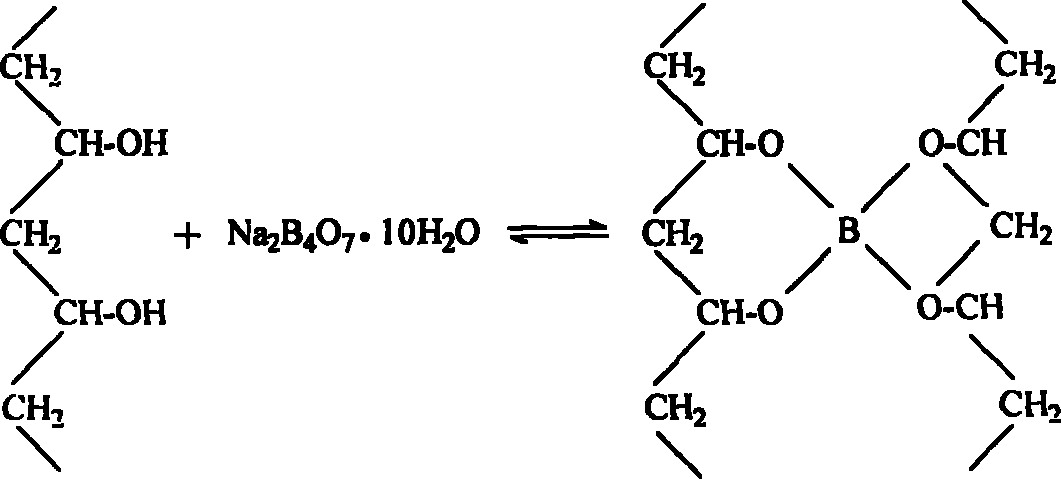Method for preparing ultrafiltration film of poly-ether-sulfone and anti-protein-contamination type
A polyethersulfone and protein technology, applied in chemical instruments and methods, membrane technology, semi-permeable membrane separation, etc., can solve the problems of difficult control of modification effect, harsh conditions, complicated operation, etc., and achieve improved resistance to protein and oil The ability of molecular contamination, mild conditions, and the effect of simple preparation methods
- Summary
- Abstract
- Description
- Claims
- Application Information
AI Technical Summary
Problems solved by technology
Method used
Image
Examples
Embodiment 1
[0016] Preparation of modified polyethersulfone anti-protein fouling ultrafiltration membrane (membrane 1)
[0017] Weigh 7.2 grams of polyethersulfone and 26.8 grams of N,N-dimethylformamide into a three-necked flask, and heat and stir in a constant temperature water bath at 60°C for about 0.5 hours. After the polyethersulfone is completely dissolved, weigh 6.0 grams of polyethylene glycol with a molecular weight of 2000 as a porogen and add it to the solution, heat and stir at 60 °C for about 4 hours to dissolve, and mix well to obtain a casting solution a. Let stand for 2 hours for defoaming. After cooling to room temperature, pour the casting liquid a on the glass plate to scrape the film, place it in the air for 10 to 30 seconds, then put it in a water bath to solidify into a film, soak it in deionized water for 24 to 36 hours to obtain a blank polyether Sulfone ultrafiltration membrane b;
[0018] Weigh 1.0 g of polyvinyl alcohol, add 199.0 g of deionized water, heat a...
Embodiment 2
[0025] Preparation of modified polyethersulfone anti-protein fouling ultrafiltration membrane (membrane 2)
[0026] Weigh 7.2 grams of polyethersulfone and 26.8 grams of N,N-dimethylformamide into a three-necked flask, and heat and stir in a constant temperature water bath at 60°C for about 0.5 hours. After the polyethersulfone is completely dissolved, weigh 6.0 grams of polyethylene glycol with a molecular weight of 2000 as a porogen and add it to the solution, heat and stir at 60 °C for about 4 hours to dissolve, and mix well to obtain a casting solution a. Let stand for 2 hours for defoaming. After cooling to room temperature, pour the casting liquid a on the glass plate to scrape the film, place it in the air for 10 to 30 seconds, then put it in a water bath to solidify into a film, soak it in deionized water for 24 to 36 hours to obtain a blank polyether Sulfone ultrafiltration membrane b;
[0027] Weigh 2.0 grams of polyvinyl alcohol, add 198.0 grams of deionized water...
Embodiment 3
[0031] Preparation of modified polyethersulfone anti-protein fouling ultrafiltration membrane (membrane 3)
[0032] Weigh 7.2 grams of polyethersulfone and 26.8 grams of N,N-dimethylformamide into a three-necked flask, and heat and stir in a constant temperature water bath at 60°C for about 0.5 hours. After the polyethersulfone is completely dissolved, weigh 6.0 grams of polyethylene glycol with a molecular weight of 2000 as a porogen and add it to the solution, heat and stir at 60 °C for about 4 hours to dissolve, and mix well to obtain a casting solution a. Let stand for 2 hours for defoaming. After cooling to room temperature, pour the casting liquid a on the glass plate to scrape the film, place it in the air for 10 to 30 seconds, then put it in a water bath to solidify into a film, soak it in deionized water for 24 to 36 hours to obtain a blank polyether Sulfone ultrafiltration membrane b;
[0033] Weigh 4.0 grams of polyvinyl alcohol, add 196.0 grams of deionized water...
PUM
 Login to View More
Login to View More Abstract
Description
Claims
Application Information
 Login to View More
Login to View More - R&D
- Intellectual Property
- Life Sciences
- Materials
- Tech Scout
- Unparalleled Data Quality
- Higher Quality Content
- 60% Fewer Hallucinations
Browse by: Latest US Patents, China's latest patents, Technical Efficacy Thesaurus, Application Domain, Technology Topic, Popular Technical Reports.
© 2025 PatSnap. All rights reserved.Legal|Privacy policy|Modern Slavery Act Transparency Statement|Sitemap|About US| Contact US: help@patsnap.com

